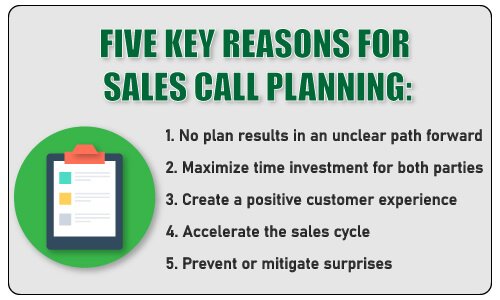It’s common for sales professionals – both new and seasoned veterans – to run into bumps in the road from time to time that results in a struggle to achieve sales goals. Changing market conditions, taking on a new territory, loss of “that big deal” they invested lots of time into, and a variety of other causes can all be contributing factors to missed sales goals. Whatever the reason, Owners and Sales Leaders need to find ways to positively support their struggling sales reps to help them get them back on the right track.
|
THOUGHT-PROVOKING TRIVIA:
Out of 2,355 small-to-mid businesses surveyed,
what percentage do not have a plan to address gaps in sales competency?
a. 48% b. 74% c. 92%
Scroll to bottom of this article to see the answer.
|
A starting point to isolating skill gaps is to go back to basics by utilizing a proven sales call planning methodology. The Sales Leader will benefit by leveraging the model as a diagnostic tool. The salesperson will find it to be a helpful guide that enables them to produce stronger, more consistent customer engagement results.
 Sales reps must always keep in mind that the customer being called on typically has limited time and budget, and a plethora of other options to choose from. Effective call planning relates to all sales interactions, at all stages of the customer lifecycle. Investing time in call planning is a best practice for any salesperson who is looking for better control of their sales process and customer relationships, not just a struggling sales rep. When a call is made with clear direction and purpose, it provides the salesperson with more confidence and the customer with a better experience, which will lead to greater success.
Sales reps must always keep in mind that the customer being called on typically has limited time and budget, and a plethora of other options to choose from. Effective call planning relates to all sales interactions, at all stages of the customer lifecycle. Investing time in call planning is a best practice for any salesperson who is looking for better control of their sales process and customer relationships, not just a struggling sales rep. When a call is made with clear direction and purpose, it provides the salesperson with more confidence and the customer with a better experience, which will lead to greater success.
- Pre-Call Planning
- Call Objectives
- Discovery Questions
- Value Proposition / Points of Differentiation
- Desired Next Steps
- In-Call Action
- Key Information Gathered During Call
- Resulting Action Items – Sales Rep and Customer assignments
- Next Step Agreement
- Post-Call Review
- Was the Call Objective achieved?
- What could have been done differently?
- Key Take-aways
As you can see, an effective approach to sales call planning involves action items for the salesperson before, during, and after the call. With planning, sales reps will gain a clear view of what they want to get out of the interaction, and the ability to envision what the end result will be. Remember: Every sales interaction should be intentional. When a call is made with purpose, it’s going to have a greater impact.
In addition to equipping your salespeople with a sales call planning method, sales coaching involvement is critical, especially for a struggling sales rep. The most effective involvement is when the Owner or Sales Leader participates in sales calls (in-person, or video calls). Be sure to spend time before entering the call by asking the salesperson about their pre-call plan. Just as important, spend time immediately after by talking through post-call review elements. This is when the most powerful learning can occur. Another effective coaching method is to utilize the sales call planning model as a diagnostic tool during the Sales Leader’s routine one-on-one meetings with each salesperson. After the sales team has had proper training on sales call planning, this can be a productive method to keep a pulse on how well the salesperson is able to independently approach their sales calls to achieve desired outcomes.
Both coaching methods will enable Owners and Sales Leaders to quickly identify areas a salesperson may need help to improve their sales competency. Listen closely for these coaching opportunities as your sales rep shares how they navigated the sales call:
- Based on who their calls are with, are they clear on target market and who they should be meeting with (i.e. the appropriate buyer persona)?
- Have they set their call objectives and desired next steps to align with your proven sales process?
- How well are they differentiating their product/service? Do they have a clear understanding of the company’s full value proposition and the ability to effectively articulate it?
- Do they have a succinct and agreed upon next step established?
As an added value, download my Sales Call Planning Guide, a deliverable that can be put into practice with your sales team today!
Implementing a “back to basics” methodology, like sales call planning is a step in the right direction to help your struggling sales rep but it is commonly not the full solution. For long term success, it’s critical to evaluate the current sales infrastructure in which your salesperson operates. Without a best practices platform that effectively integrates people, process and systems, Owners and Sales Leaders will continually find themselves chasing symptoms instead of fixing root cause problems.
by investing 5-minutes to take my Sales Agility Assessment
|
TRIVIA ANSWER: Out of 2,355 small-to-mid businesses surveyed*, 92% say they do not
have a plan to address gaps in sales competency.
If you are amongst the 92%, this is a BIG sales optimization opportunity!
Feel welcome to reach out to talk about how to address this gap.
*Data compiled from 2,355 Owners and Sales Leaders that took Sales Xceleration Sales Agility Assessment® through December 2021.
|







Leave A Comment